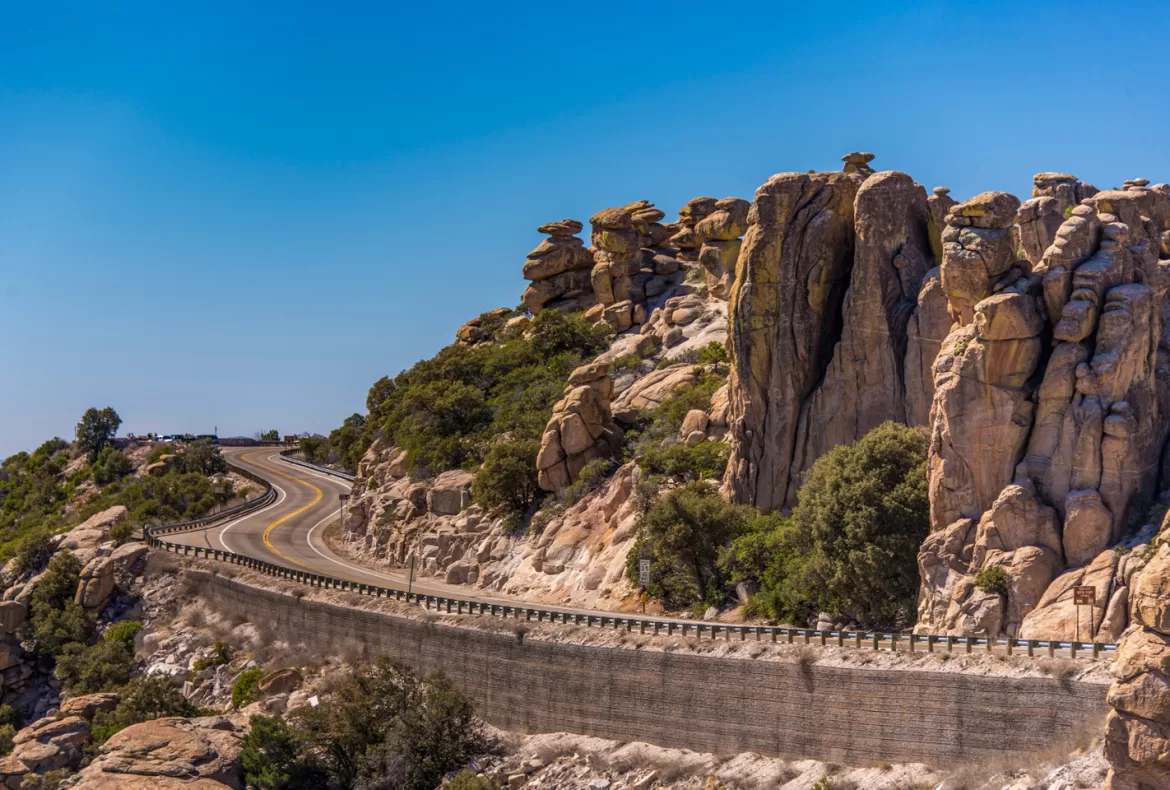Tucson, Arizona, is sometimes called a “year-round playground,” and it’s easy to see why – this charming town and surrounding area are full of things to do.
By Emily Fagan, F547779
Photos by Emily and Mark Fagan
January 2024
Driving through the urban jungle of Arizona’s largest desert cities, my husband, Mark, and I find it hard to believe that the once-wild Arizona territory gained statehood just 112 years ago. The growth and change have been exponential! Many of the highways crisscrossing the state were rutted, single-lane dirt roads back when today’s senior citizens were just kids, and several of the interstates weren’t even in the planning stages.
The advent of air conditioning transformed Arizona’s landscapes forever. Yet, despite the population explosion, the desert winds still carry the whispers of bygone voices across the vast, saguaro-cactus-studded Sonoran Desert. Hints of the ancient indigenous cultures from millennia ago, the Spanish conquistadors a few centuries ago, and the American settlers just 150 years ago can still be found and felt, especially in and around the historic city of Tucson, which is affectionately known as “The Old Pueblo.”
Back when Arizona gained its statehood in 1912, there was a fierce rivalry among Arizona’s three largest cities: Tucson, Phoenix, and Yuma. After some political wrangling, Phoenix emerged as the state capital and commercial hub, while Yuma was left with the prison known as “The Hell Hole of the West.” Meanwhile, Tucson housed the university and laid claim to all things cultural and intellectual. Whiffs of these traits have stayed with these cities, and Tucson is now not only colorful and artsy, but it’s a favorite among RVers.
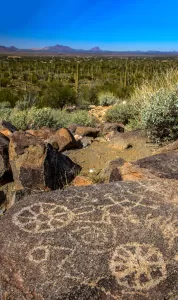
In Saguaro National Park, ancient petroglyphs carved into the rock are visible at Signal Hill.
HOME OF THE ANCIENTS
Northwest of downtown, Saguaro National Park is home to long-lived cacti that were mere sprouts during Arizona’s territorial days and to prehistoric rock art carved by the ancients many centuries ago. Saguaro cacti stand tall with their arms held high, the sentinels of the Sonoran Desert, and in this park, they are beyond the reach of urban development and the threat of relocation. Endless hiking trails weave between them.
A collection of petroglyphs pecked in the rocks by earlier peoples decorate a group of boulders atop Signal Hill. There are images of all kinds, including bighorn sheep. We were intrigued by the geometric spiral and wheel-shaped petroglyphs. Were these markers created by specially trained members of the tribe? Or were they just doodles made by idle hands in a creative mood? We’ll never know for sure!
A GLIMPSE OF THE SPANISH CONQUISTADORS
For a day trip out of town, we ventured 10 miles south of Tucson to San Xavier del Bac Mission church, located on the Tohono O’odham Indian Reservation. As we wandered the grounds, we mused that some residents of the area today may be descendants of the Indians who were converted to Catholicism by the Spanish Jesuit missionaries who settled New Spain in the American Southwest and Mexico over 400 years ago.
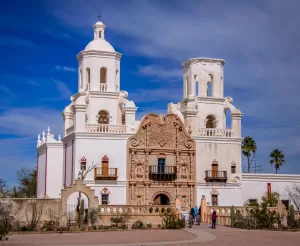
San Xavier del Bac Mission church is often called the “white dove of the desert.”
San Xavier del Bac Mission, the northernmost mission in New Spain, was founded in 1692 by the Italian Jesuit missionary Father Eusebio Kino. Ironically, in that exact same year, the Salem witch trials were happening on the other side of the continent in Massachusetts! The mission showcases the elegant Spanish Colonial architecture of the era, with rounded arches, a fantastic bell tower, and a very ornate altar. In recent years, it has undergone extensive renovations. Meticulous craftsmanship by artisans from Italy, Mexico, and the Tohono O’odham tribe have brought the mission back to its former glory.
One of the most beautiful artifacts in the church is an antique book that is on display under glass. It features Latin verses written in exquisite calligraphy. Outside, a pair of lion statues guard the mission grounds. Climbing up a hill, we were able to get a bird’s-eye view of the mission in its desert setting.
HISTORIC ARCHITECTURE AND BARRIO VIEJO
One of our favorite activities in the city of Tucson is to stroll the streets in the Barrio Viejo (Spanish for “Old Neighborhood”). Many original adobe-style homes are punctuated with brightly painted doorways deeply recessed in the 18-inch-thick mud-based walls. These walls were ideal for Tucson’s intense climate, because they kept the interior of the house cool during the baking-hot summer days and held in the heat when overnight winter temperatures dropped below freezing.
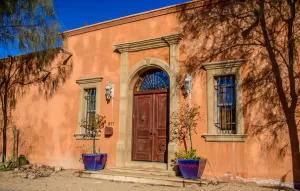
Barrio Viejo, with its original adobe-style homes, reveals an intriguing look at Tucson’s cultural history.
Tourists can pick up a self-guided walking tour map at the visitors center at 115 N. Church Ave. — a colorful building with red and purple dominating the outside decor. Docent-guided walking tours are available as well. Nearby, the former Pima County Courthouse is an architectural delight built in 1928 in the Mission and Spanish Colonial Revival styles.
MEET ME AT MAYNARDS
Every Monday night, a really fun gathering of friends and neighbors takes place at a downtown restaurant called Maynards Kitchen. With a youthful verve that suits this vibrant town, a large crowd leaves for a long walk around town at sunset (dogs on leashes allowed!). We loved the camaraderie of this unique event. Topping it off with a microbrew at an outdoor table in front of Maynards Kitchen was the perfect ending.
DESERT FLORA AND FAUNA
Approximately 15 miles west of Tucson, the Arizona-Sonora Desert Museum features animals of all kinds that are native to the state, including mountain lions! Founded in 1952, this zoological park is world renowned because it presents the flora and fauna of the Sonoran Desert and nearby ecosystems. From bighorn sheep to coyotes, bobcats, javelinas, ocelots, wolves, and parrots, Arizona’s wildlife is easily seen in large enclosures.
The trick to visiting the Arizona-Sonora Desert Museum is to arrive right when it opens, or slightly before. At this time, the animals are active in their enclosures because they’ve just had breakfast. An hour later, most of them have bedded down for a nap in a hidden nook or cranny, so latecomers see one seemingly empty enclosure after another!
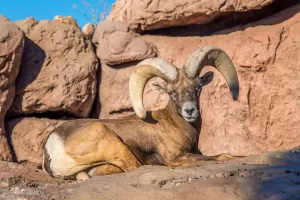
Bighorn sheep are among the residents of the Arizona-Sonora Desert Museum.
The highlight of our visit to the museum was the outdoor Raptor Free Flight show. As a small group of visitors craned their necks toward the sky, two handlers on either side of us released and caught one big bird of prey after another. Each bird — from great horned owl to peregrine falcon and more — would soar into the sky, happy to be free. What a thrill it was to see these birds riding the thermals for a few moments of pure joy. A handler would then hold out a delicious treat, like a handful of raw meat, and gradually lure the bird out of the sky onto his leather glove for a snack.
FROM DESERT FLOOR TO FORESTED PEAKS
Mt. Lemmon’s summit is at a 9,159-foot elevation, while the base in Tucson is at just 2,490 feet. Driving this mountain from bottom to top is a memorable experience that takes you through several ecosystems, from the low-lying Sonoran Desert to aspen-filled forests, in just 32 miles. There are many turnouts for enjoying sweeping views of Tucson below. If driving that steep road seems like an accomplishment, watching groups of cyclists tackling it on their bicycles is literally breathtaking! Because of the 10 percent grades in some places, we suggest owners of bigger RVs use their towed/towing vehicle. Shorter rigs can stay in campgrounds a few miles from the summit but must have strong engines to make the grade.
RECREATION IN THE DESERT
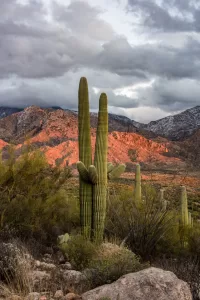
Saguaro cacti thrive at Catalina State Park.
Located just north of downtown Tucson, Catalina State Park is a wonderful place, not only for an immersion in lush Sonoran Desert scenery but for RV camping as well. Set in a valley at the base of the gorgeous Santa Catalina Mountains, the campground offers 120 electric and water sites, most of which are suitable for any size RV. Besides camping in the midst of stunning scenery, eight beautiful hiking, biking, and horseback riding trails are just steps from your RV door. Our favorite was the 50-Year Trail. It follows a ridgeline, and the Catalina Mountains light up in a radiant golden glow at sunset.
Desert creatures abound at this park, and like all desert dwellers, they welcome a drink of water. If you want to coax small birds and harmless mammals into your campsite, simply leave a shallow dish of water on the ground away from your RV. A hummingbird feeder will attract eager customers in no time, and sometimes several species at once! Whether or not you share your campsite with furry or feathered visitors, there’s nothing like basking in the afternoon sunshine in Arizona.
We have loved every trip we’ve made to the Tucson area, and we discover more gems each time we go. If you visit during FMCA’s 108th International Convention & RV Expo, keep an eye out for the glorious spring wildflower displays alongside all the desert roads on the outskirts of town!
MORE INFO
Arizona-Sonora Desert Museum
2021 N. Kinney Road
Tucson, AZ 85743
desertmuseum.org
(520) 883-2702
Catalina State Park
11570 N. Oracle Road
Tucson, AZ 85737
azstateparks.com/catalina
(520) 628-5798
Meet Me at Maynards
400 N. Toole Ave.
Tucson, AZ 85705
beyond-tucson.org/programs/meet-me-at-maynards
(520) 545-0577
Mt. Lemmon
USFS Supervisor’s Office
300 W. Congress St.
Tucson AZ 85710
fs.usda.gov/recarea/coronado/recarea/?recid=25678
(520) 388-8300
Saguaro National Park
3693 S. Old Spanish Trail
Tucson, AZ 85730
nps.gov/sagu/index.htm
(520) 733-5153
San Xavier del Bac Mission
1950 W. San Xavier Road
Tucson, AZ 85746
sanxaviermission.org
(520) 294-2624

